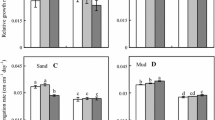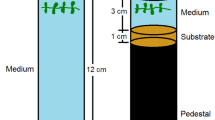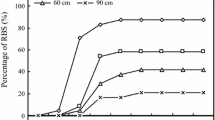Abstract
In this paper, sinking and growth of apexes and mid-stems of Myriophyllum spicatum L., Hydrilla verticillata (L.f.) Royle and Ceratophyllum demersum L. in concrete ponds containing eutrophic water and sediment were investigated. Sinking rates of apexes and mid-stems reached 34.8% and 4.4% at the 6 th day and 91.1% and 66.7% at the 22 nd day for M. spicatum, 57.8% and 55.6% at the 6 th day and 100% and 97.8% at the 22 nd day for H. verticillata, 18.9% and 86.7% at the 6 th day and 95.6% and 100% at the 22 nd day for C. demersum, respectively. Most sunken fragments established themselves successfully with significant growth. Total shoot length of plantlets developed from apexes and mid-stems increased by 399% and 61% for M. spicatum, 593% and 256% for H. verticillata and 114% and 104% for C. demersum, respectively. The results showed that it was feasible to establish submersed macrophytes via sinking and colonization of shoot fragments clipped off manually.
Similar content being viewed by others
References
Carpenter S R, Caraco N F, Correll D L, et al. Nonpoint Pollution of Surface Waters with Phosphorus and Nitrogen[J]. Ecol Appl, 1998, 8: 559–568.
Gumbricht T. Nutrient Removal Processes in Freshwater Submersed Macrophyte Systems[J]. Eco Eng, 1993, 2: 1–30.
Wu Zhenbin, Qiu Dongru, He Feng, et al. Effects of Rehabilitation of Submerged Macrophytes on Nutrient Level of a Eutrophic Lake[J]. Chinese Journal of Applied Ecology, 2003, 14: 1351–1353 (Ch).
Mcfarland D G, Rogers S J. The Aquatic Macrophyte Seed Bank in Lake, Onalaska, Wisconsin[J]. J Aquat Plant Manage, 1998, 36: 33–39.
Harwell M C, Havens K E. Experimental Studies on the Recovery Potential of Submerged Aquatie Vegetation after Flooding and Desiccation in a Large Subtropical Lake[J]. Aquat Bot, 2003, 77: 135–151.
Li Wei, Liu Guihua, Xiong Binghong, et al. The Restoration of Aquatic Vegetation in Lakes of Poyang Lake Nature Reserve after Catastrophic Flooding in 1998[J]. Journal of Wuhan Botanical Research, 2004, 22: 301–306 (Ch).
Chen Hongda. Impact of Aquaculture on the Ecosystem, the Donghu Lake, Wuhan[J]. Acta Hydrobiologica Sinica, 1989, 13: 359–368 (Ch).
Smart R M, Dick G O, Doyle R D. Techniques for Establishing Native Aquatic Plants[J]. J Aquat Plant Manage, 1998, 36: 44–49.
Rogers K H, Breen C M. Growth and Reproduction of Potamogeton crispus in a South African Lake[J]. J Ecol, 1980, 68: 561–571.
Madsen J D, Eichler L W, Boylen C W. Vegetative Spread of Eurasian Watermilfoil in Lake George, New York[J]. J Aquat Plant Manage, 1988, 26: 47–50.
Kimbel J C. Factors Influencing Potential Intralake Colonization by Myriophyllum spicatum L[J]. Aquat Bot, 1982, 14: 295–307.
Sabol B M. Environmental Effects of Aquatic Disposal of Chopped Hydrilla[J]. J Aquat Plant Manage, 1987, 25: 19–23.
Jian Yongxing, Wang Jianbo, He Guoqing, et al. A Comparative Study of Aquatic Plant Diversity of Haikou, Taibai and Wushan Lake in Hubei Province of China[J]. Acta Ecological Sinica, 2001, 21: 1815–1824 (Ch).
Chen Zhongyi, Lei Zexiang, Zhou Jin, et al. Monthly Quantitative and Biomass Dynamics of Six Submerged Macrophytes Populations in Liangzi Lake[J]. Acta Hydrobiologica Sinica, 2000, 24: 582–588 (Ch).
Smith C S, Adams M S. Phosphorus Transfer from Sediments by Myriophyllum spicatum[J]. Limnol Oceanogr, 1986, 31: 1312–1321.
Crossley M N, Dennison W C, Williams R R, et al. The Interaction of Water Flow and Nutrients on Aquatic Plant Growth[J]. Hydrobiologia, 2002, 489: 63–70.
Nichols D S, Keeney D R. Nitrogen Nutrition of Myriophyllum spicatum: Uptake and Translocation of 15N by Shoots and Roots[J]. Freshwat Boil, 1976, 6: 145–154.
Carignan R, Kalff J. Phosphorus Sources for Aquatic Weeds: Water or Sediments? [J]. Science, 1980, 207: 987–989.
Madsen T V, Cedergreen N. Sources of Nutrients to Rooted Submerged Macrophytes Growing in a Nutrient-Rch Stream [J]. Freshwat Boil, 2002, 47: 283–291.
Langeland K A, Sutton D L. Regrowth of Hydrilla from Axillary Buds[J]. J Aquat Plant Manage, 1980, 18: 27–29.
Author information
Authors and Affiliations
Additional information
Foundation item: Supported by the National Natural Science Foundation of China (39925007), the High Technology Research and Development Program of China (2002AA601021) and the Knowledge Innovation Program Key Project of Chinese Academy of Sciences (KSCX2-SW-102)
Biography: WU Zhenbin (1956–), male, Professor, Ph. D., research direction: environmental biology and environmental engineering.
Rights and permissions
About this article
Cite this article
Wu, Z., Zuo, J., Ma, J. et al. Establishing submersed macrophytes via sinking and colonization of shoot fragments clipped off manually. Wuhan Univ. J. of Nat. Sci. 12, 553–557 (2007). https://doi.org/10.1007/s11859-006-0057-6
Received:
Issue Date:
DOI: https://doi.org/10.1007/s11859-006-0057-6




